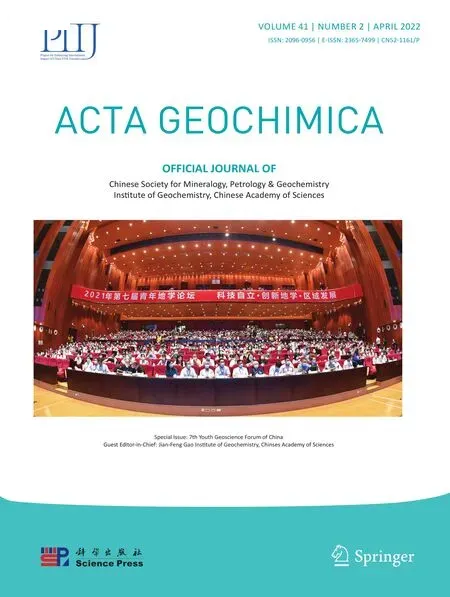Direct Re–Os dating of pyrite from the Jianchaling Au deposit,West Qinling, China
Suwei Yue ? Xiaohua Deng ? Zhenwen Lin
Abstract The West Qingling Orogen is endowed with more than 1100t gold resources and with 50 gold deposits,ranking it the third-largest gold province in China.The Jianchaling giant gold deposit with 52 t gold reserve is a typical orogenic gold deposit in West Qinling Orogen.The deposit lacks accurate and direct metallogenic age.Five pyrite samples collected from the quartz-polymetallic veins yielded Re–Os isochron age of 206.3 ± 2.7 Ma and an initial 187Os/188Os ratio of 0.1154 ± 0.0016 (MSWD =0.54).The pyrites were analyzed by the electron microprobe (EMPA), and the results show that the iron content ranges from 45.1 to 47.8 wt.%, the sulfur content ranges from 52.0 to 53.5 wt.%, and the gold content varies from 0.022 to 0.035%.The higher gold content means that gold is closely related to pyrite,which is a gold-bearing mineral.Moreover, the age is very close to the previous fuchsite 40Ar/39Ar isotopic ages of 199–194 Ma, which indicates that the gold mineralization at Jianchaling has begun in the Late Triassic (206 Ma), and continued into the Early Jurassic.Through summary and comparison, it is found that the gold metallogenic age of the southern ore belt of the Mian-Lue Suture belt in the West Qinling is younger than that of the northern ore belt, suggesting that the gold deposits in the southern ore belt such as Jianchaling were formed in the transitional period from oceanic subduction to continental collision.
Keywords Jianchaling ?Pyrite Re–Os ?West Qinling ?Orogenic gold deposit
1 Introduction
The orogenic gold deposit is the most important gold source in the world (Goldfarb et al.2019).The precise geochronological data can help us to establish a temporal framework of events, which can provide a geologic interpretation of mineralization.Direct determination of the ages of hydrothermal deposits is normally hampered by the lack of minerals that are suitable for conventional radiometric methods (Yang and Zhou 2002).Several isotopic dating methods, such as sulphides Rb–Sr (Wang et al.2018b), calcite/dolomite Sm–Nd (Liu et al.2014; Wang et al.2020), sericite/fuchsite40Ar39/Ar (Lin et al.2017;Yue et al.2017;Wang et al.2020;Yu et al.2020a,b),and hydrothermal rutile and monazite U–Pb(Doyle et al.2015;Deng et al.2020; Feng et al.2020; Qiu et al.2020; Liu et al.2021)have been applied.However,these methods are used to determine the age of gold mineralization indirectly.In other words, the crystallization of these hydrothermal minerals often has a time lag with gold precipitation.It is obvious that these hydrothermal minerals may represent hydrothermal activity but are not exactly coeval to gold deposition.Yue et al.(2017)conducted40Ar/39Ar dating of hydrothermal fuchsite that collected from the Jianchaling gold deposit and obtained the mineralization age between 199 and 194 Ma,which is far from the 144 Ma obtained by the K–Ar method of fuchsite that collected from the same deposit (Huang and Ran 1996).
The age of most carlin and carlin-like gold deposits in the West Qinling Orogen concentrates at the end of the Triassic to the beginning of the Jurassic (described later).However, the ore-forming age of Jianchaling is more than 10 Ma later than that of the Huachanggou orogenic gold deposit (212–209 Ma, Lin et al., 2017).Moreover, the Jianchaling deposit and the Huachanggou deposit are very close in location (Fig.1c).The Jianchaling gold deposit is located on the south side of the Mianlue Suture, and its geotectonic location is very special.Determination of its metallogenic age is not only indicative of the fine description of the metallogenic structure of the deposit but also indicative of the gold metallogenesis in the West Qinling Orogen.
Re and Os belong to chalcophile and ferrophilic elements(Zhao and Zhang 1988;Li et al.2018),which tend to be concentrated in the Earth core and sulphide minerals.Re–Os geochronometer is the most direct and effective method to data the metallogenic age and trace the source of ore-forming materials for metallic sulphide deposits(Lawley et al.2013; Zhao et al.2013; Zhu and Sun 2013).Re–Os isotope of molybdenite can be used for dating,which has been widely used in porphyry deposits (Zhong et al.2014;Mi et al.2015;Tessalina and Plotinskaya 2017;Wang et al.2018a;Pollard et al.2021).With the increasing accuracy of testing, the chalcopyrite or pyrite are also can be used for Re–Os dating at a variety of hydrothermal systems,e.g.,VMS(Deng et al.2016;Pirajno et al.2016),porphyry(Cardon et al.2008; Liu et al.2012; Zhang et al.2016; Meng et al.2018), skarn (Deng et al.2017),epithermal (Kirk et al.2014), sediment-hosted Cu–Au(Selby et al.2009; Huang et al.2013), IOCG (Zhao et al.2013;Zhu and Sun 2013;Song and Song 2015;Barra et al.2017) and orogenic Au deposits (Lawley et al.2013; Ding et al.2016; Zhang et al.2017).Thus, the Re-Os dating of pyrite provides an opportunity to accurately constrain the age of gold mineralization in the Jianchaling Au deposit.
The pyrite is a gold-bearing mineral in the Jianchaling Au deposit, Western Qinling Orogen and thus formed coevally with gold mineralization (Ren 2008).In the present study, we use pyrite Re–Os geochronometers to constrain the mineralization events that are represented at the Jianchaling gold deposit.The new age constrains the absolute timing of gold mineralization in the Jianchaling area and provides improved constraints on its genetic context with regional tectonic events.
2 Geological background
The Mianxian-Lueyang-Yangpingguan area (MLY) is located on the north margin of the Yangtze Craton(Fig.1),and it is bounded by the Hanjiang Fault and Mian-Lue Suture to south and north respectively(Fig.1c).The MLY area hosts a large number of mineral deposits,i.e.,Au,Cu,Ni, Zn and Pb, and is known as the Golden Triangle.The main outcrop strata of MLY include the Neoarchean Yudongzi Group (with zircon U–Pb age of 2703 ± 26 Ma and 2661 ± 17 Ma) (Zhang et al.2010), the Neoproterozoic Bikou Group,the Late Neoproterozoic Duantouya and Jiudaoguai formations with metasedimentary carbonate sequences, and the Early Carboniferous Lueyang Formation (Fig.1c).The NW- and NE-trending ductile–brittle shear zones and brittle faults of MLY are caused by multiple, variable intense high-pressure deformation and metamorphism.In addition, the distribution of intrusion rocks and mineralization in the area is also controlled by these structures.
The Jianchaling Au deposit belongs to Lueyang County in the administrative division, and 25 km southeast of county seat (Fig.1c).The geological units include the Neoarchean Yudongzi Group, the Neoproterozoic Bikou Group, the Late Neoproterozoic Duantouya, Jiudaoguai Formations, and the Lueyang Group (Fig.2).The granite porphyry dykes and albite veins are exposed in the middle of the mining area whereas the granite veins are exposed in the central and southern of the mining area (Fig.2).The major WNW-trending Hejiayan and NW-trending Xiqugou faults in the mining area and the ductile shear zones have been identified (Jiang et al.2010).The Hejiayan Fault and Xiqugou Fault are ore-controlling structures, which are featured by brittle to brittle-ductile fractures.The Jianchaling gold deposit is composed of north and south gold belts.Several gold orebodies have been identified in the north gold belt, which occurs in the contact zone between ultramafic rocks and the Late Neoproterozoic dolomite.Among them,the largest ore body is 1950 m in length and 0.27–22.67 m in width,with a northward dipping of 43°to 88°.The gold reserves of the Jianchaling deposit are 52 t at a grade of 5 g/t (Mao et al.2002).
The precious minerals in quartz veins are native gold and a small amount of electrum (Ren 2008; Yue et al.2017, 2018).The ore minerals include pyrite, a small amount of hematite,magnetite,limonite,chromite,realgar,and orpiment; gangue minerals are mainly composed of dolomite, calcite, and quartz, with a small amount of serpentine and albite (Yue et al.2017, 2018).
Four types of pyrite(Py1,Py2,Py3 and Py4)have been identified by Yue et al.(2017).Py1 is pre-deformed and usually forms corrosion and fracture particles with a diameter of less than 100 μm (Fig.3a).Py2 particles are coarse, non-hexahedral to subhedral in shape, disseminated,or massive in texture(Fig.3b,c).Py3 is hypohedral with medium grain sizes(1–2 mm in diameter)and usually contains inclusions of pentlandite, pyrrhotite, and chalcopyrite (Fig.3d).Py4 is very fine (<10 μm in diameter)in a ring-subhedral shape,distributed in the alteration zone containing quartz-dolomite-realgar veinlets.
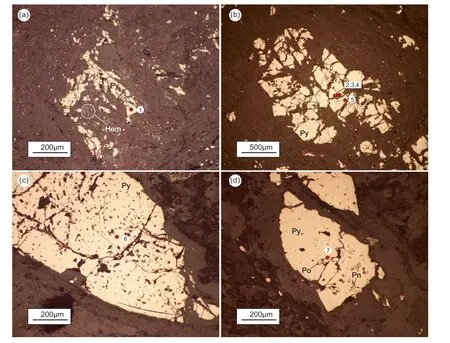
Fig.3 Photographs showing pyrite of the Jianchaling Au deposit. a Py1 is partly oxidized to hematite; b Py2 with brittle fracture, and honeycomb-like holes in the core that may be caused by fluid metamorphosed;c the coarse-grained Py2;d Py3 contains inclusions of pentlandite,pyrrhotite and chalcopyrite.Abbreviations: Hem- hematite; Pn-pentlandite; Po-pyrrhotite; Py-pyrite; Sph-sphalerite
3 Samples and analytical methods
Five pyrite samples (hjy-18, hjy-19, 780-50-8, 800-53-1,800-52-3) were collected from the Jianchaling orebody.The characteristics of the samples used for analysis are shown in Fig.4.These samples are silicified ore,belonging to quartz-polymetallic stage.
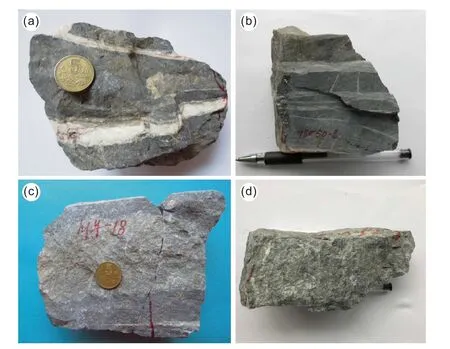
Fig.4 Samples characteristics from the Jianchaling Au deposit. a sample hjy-19, dissiminated ores cut by comb-like quartz + calcite + ferricalcite;b sample 780-50-8,dissiminated ores cut by comb-like quartz + calcite + realgar + orpiment veinlets;c the disseminated pyrite from sample hjy18 and d sample 800-52-3
Gold-bearing pyrites were analyzed by JEOL JXA-8100 Electron probe micro-analyzer (EMPA) at the Guangzhou Institute of Geochemistry, Chinese Academy of Sciences(Table 1).Pyrite crystals were separated to approximately 1000 to 2000 mg by using the traditional isolation methods.
Re–Os isotope analyses were carried out in the State Key Laboratory of Isotope Geochemistry of the Guangzhou Institute of Geochemistry, Chinese Academy of Sciences.The chemical separation procedure(Du et al.1994;Li et al.2015a, 2010, 2009; Pirajno et al.2016; Qu et al.2009;Zhou et al.2012) is described here briefly: The enriched190Os and185Re for preparing mixing spike were obtained from Oak Ridge National Laboratory.A Carius tube (a thick-walled borosilicate glass ampoule) digestion was used.The weighed sample is loaded into the Carius tube through a thin neck long funnel.The weighted190Os–185Re spike and 3 mL HCl, 5 mL HNO3and 1 mL H2O2are loaded while the bottom part of the tube is frozen at - 50 to - 80 °C in ethanol–liquid nitrogen slush; the top is sealed with a natural gas torch.The tube is then placed in a stainless-steel jacket and heated for 24 h at 230 °C.Upon cooling, keep the bottom of the tube frozen, and we break the neck of the tube.The osmium is separated by the method of direct distillation from Carius tube for 50 min and is trapped in 5 mL 50% HBr.Then the HBr solution containing Os is purified by the micro-distillation method(Creaser et al.1991).The residual Re-bearing solution is saved in a 150 mL Teflon beaker for Re separation.The residual Re-bearing solution is heated to near-dryness twice.10 mL of 25% NaOH are added to the residue followed by Re extraction with 10 mL of acetone in a 120 mL Teflon separation funnel.Discard the water phase.Wash acetone phase with 2 mL of 25% NaOH.Transfer the acetone phase to 100 mL beaker that contains 2 mL of water.Evaporate to dryness, and picked up in 2% HNO3.The purified Os and Re were loaded to Pt filaments respectively and analyzed using negative ion thermal ionization mass spectrometry (NTIMS) using a second electron multiplier(SEM)in peak-hopping mode for Os and by static Faraday collectors for Re.Measured Re and Os isotopic ratios were corrected for isobaric oxygen interferences, mass fractionation using185Re/187Re = 0.59738,and192Os/188Os = 3.08271 (Li et al.2015a, b).During the entire procedure, one Chinese certified reference materials(JCBY sulfide), and one sample blank was used for data quality control.Average blanks for the method are ~1.4 pg Re and ~0.09 pg Os.The analytical reliability was tested by analyses of Certified Reference Materials JCBY.The sample GBW04477 (JCBY) contains Re and187Os/188Os ratio of 38.447 ± 0.284 and 0.3355 ± 0.0005 ppb, respectively, consistent with their literature values (Qu et al.2009).
4 Analytical results
The results of EMPA of pyrite are listed in Table 1.In addition to Fe and S,pyrite also contains a small amount of Ni, Co, As, and Pb.The Fe content in pyrite ranges from 45.1 to 47.8 wt.%, and sulfur content ranges from 52.0 to 53.5 wt.%.The Au content of pyrite samples for Re–Os testing ranges from 0.022 to 0.035 wt.%(Table 1).Table 2 shows the results of Re–Os analysis of five pyrite samples.The Re concentration in pyrites ranges from 6.87 to 36.9 ppb, and the Os concentrations vary from 0.62 to 11.8 ppb.The187Re/188Os and187Os/188Os ratios vary from 3.0 to 136, and 0.1262 to 0.5849, respectively.The corresponding isochron age of 206.3 ± 2.7 Ma(MSWD = 0.54) with initial187Os/188Os ratios of 0.1154 ± 0.0016 (Fig.5).
5 Discussion
5.1 Age of the Jianchaling gold mineralization
The samples hjy-19 and 780-50-8 are the same types whilst the samples hjy-18, 800-53-1, and 800-53-3 are similar.Data are divided into two centralized areas (Fig.5), with high187Re/188Os vs187Os/188Os and low187Re/188Os vs187Os/188Os features respectively.Therefore, the Re–Os age of the pyrites is considered to be reliable.EMPA analysis shows that pyrite generally contains gold(Table 1).In addition, the previous study has shown that gold is closely related to the pyrite,dolomite,and quartz in stage 2, and pyrite is the closest (Ren 2008).The occurrence state of gold includes intergranular gold,fissure gold,wrapped gold, and microscopic gold(Ren 2008).It further shows that the pyrite is a gold-bearing mineral in Jianchaling gold deposit and formed at the same time as gold in stage 2.Therefore, pyrite Re–Os isochron age of 206.3 ± 2.7 Ma is interpreted to represent the age of the gold mineralization.

Fig.5 Re–Os isochron age for pyrites from the Jianchaling Au deposit
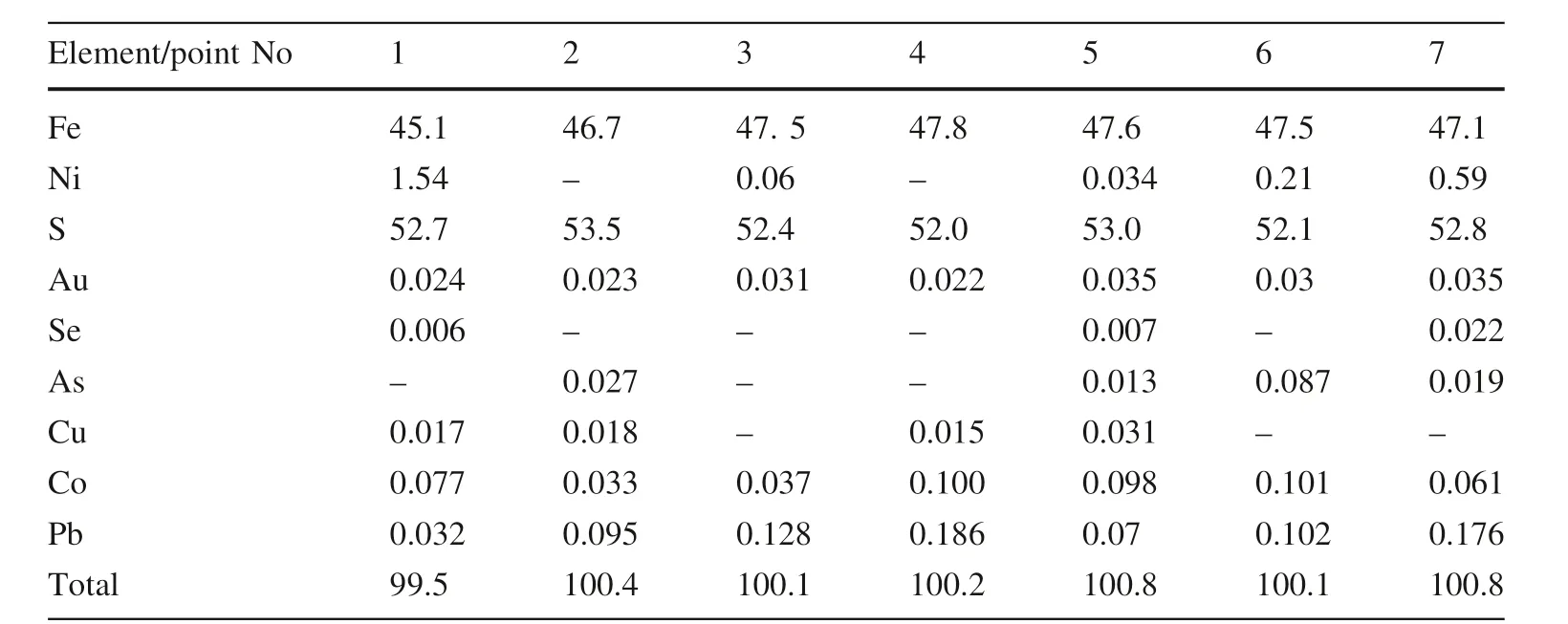
Table 1 Pyrites content analyzed by EMPA from the Jianchaling gold deposit (wt.%)

Table 2 Re–Os isotope data for pyrite from the Jianchaling gold deposit
Yue et al.(2017) has reported40Ar/39Ar isotopic age from massive fuchsite in the quartz-sulfides vein, i.e.,197.3 ± 2.0 Ma and 194.3 ± 2.4 Ma, respectively.Although mica may record the younger age due to a lowtemperature thermal disturbance, the homogenization temperatures for a quartz-sulfide vein in the Jianchaling deposit range from 160 to 220 °C(Yue et al.2017),which are lower than the closure temperatures of the Ar–Ar mica chronometers.Combined with pyrite Re–Os age and fuchsite40Ar/39Ar age, gold mineralization began at least at end of the Indosinian period (206 Ma) and continued to the Early Jurassic (194 Ma).
5.2 The genesis of the Jianchaling Au deposit
The Jianchaling gold deposit is controlled by the EWtrending ductile shear zones which mainly consist of the WNW-trending Hejiayan Fault on the south side and the NW-trending Xiqugou Fault on the north side with the latter dominating.The ore bodies are distributed both in the main faults and their secondary faults.Some ore bodies have undergone strong hematite alteration.Previous studies classified the Jianchaling gold deposit as a structural altered rock type (Zhang and Wang 1999) or Carlin-like type (Mao et al.2002).Yue et al.(2013, 2017, 2018)conducted fluid inclusions,mineralogy,and stable isotopes studies and found that the ore-forming fluids of the Jianchaling gold deposit are medium temperature metamorphic fluids.The geological characteristics of the Jianchaling deposit are consistent with those of orogenic gold deposit,and the authors concluded that Jianchaling is an orogenic gold deposit.The formation characteristics of the Jianchaling gold deposit are very similar to those of the Lijiagou gold deposit in the MLY in terms of wall rock,structural control, and mineralogy (Ren 2008) and the Lijiagou gold deposit was also classified as orogenic gold deposit (Mao et al.2002).Similarly, the Donggouba Ag–Au–Pb–Zn deposit in the MLY has the characteristics of being superimposed and re-enriched by metamorphic fluids(Wang and Li 1991), and the Huachanggou deposit is a typical orogenic gold deposit (Zhou et al.2014).All the above-mentioned evidence indicates that there was a metallogenic event of orogenic gold deposit dominated by metamorphic fluids in MLY.Combined with the mineralization age of 206 Ma,the Jianchaling gold deposit should be classified as an orogenic gold deposit.
5.3 Implication for the geodynamic setting of gold deposit
The West Qinling Orogenic belt (WQO) contains more than 50 gold deposits with total gold resources up to 1100 tons, rendering it the third-largest gold province in China(Li et al.2020).Table 3 summarizes available metallogenic ages for gold deposits in WQO.The southern gold deposit belt is distributed along the Mian-Lue Suture zone from east to west, including Mian-Lue-Yang mining area,Yangshan-Maonaoke mining area,and Dashui mining area(Fig.1b).The northern gold belt is located in the south of Shangdang Suture zone and composed of Fengxian-Taibai,Daqiao-Liba-Zhaishang, and Zaozigou deposits from east to west (Fig.1b).
Two gold metallogenic events in Indosinian and Yanshanian have been identified in the WQO (Fig.6).The Yanshanian gold deposit is represented by the Daqiao giant gold deposit, and the latest reliable metallogenic age is 150–125 Ma (Wu et al.2018).It is consistent with the metallogenic ages of gold deposits in the East Qinling,and the metallogenic peak is 135 Ma(Chen and Fu 1992;Chen et al.2004),which is explained to be related to the far-field effect of plate reorganization during the Paleo-Pacific subduction in eastern Eurasia (Wu et al.2018).
Another metallogenic period and also the most important metallogenic explosion in WQO,mainly spanned from the Late Triassic to Early Jurassic (220–190 Ma).However,there are some discrepancies in the metallogenic ages between the south ore belt and the north ore belt (Fig.6).The metallogenic ages of gold deposits in the north ore belt are generally older than 200 Ma whereas those of Jianchaling, Yangshan, and Dashui gold deposits distributed along the Mian-Lue Suture in the south ore belt are relatively younger, forming mostly between 190 and 210 Ma.
Chen and Santosh (2014) compiled paleomagnetic data and geological evidence that related to sedimentation,magmatism, and mineral systems, and concluded that the Triassic Qinling orogenic belt was an active continental margin related to the Paleo-Tethyan oceanic subduction.Li et al.(2015b) further proposed that the closure of the northernmost Paleo-Tethys ocean and the beginning of the collision between the Yangtze and the North China Craton occurred between the Triassic and Jurassic at about 200 Ma.
As discussed above, the Re–Os isochron age of the pyrite in the Jianchaling gold deposit is 206 Ma,combined with the40Ar/39Ar age of the previous fuchsite(199–194 Ma), indicating that the Jianchaling gold oreforming hydrothermal activity started from the end of the Triassic and continued to the Early Jurassic, which is consistent with the mineralization peak at the end of the Indonesian period in the WQO(Fig.6).On the other hand,it is notable that the initial187Os/188Os (0.1154 ± 0.0016)ratio of ~206 Ma pyrite from the Jianchaling deposit is consistent with subcontinental lithospheric mantle(0.105–0.129, average 0.113)187Os/188Os ratios (Shirey and Walker 1998),indicating mantle or equivalent material provided a source of mineralization.Moreover, the gold ore bodies occur at the boundary between ultramafic rocks and dolomites, and the187Os/188Os ratio of the coppernickel ore (0.1167 ± 0.0002) (Wang et al.2003) in the ultramafic rocks is close to the initial value of pyrite(0.1154 ± 0.0016), indicating ultramafic rocks may be an important source of gold mineralization.However, considering the evidence from the sulfides Sr–Nd–Pb isotope(Yue et al., 2018), the volume of ultramafic rocks in the Jianchaling mining area, and the Huachanggou large orogenic gold deposit (reserves >20t) in MLY area without ultramafic rocks, etc., the possibility that a deep mantle or equivalent providing a source of mineralization at the end of the Triassic (206 Ma) cannot be ruled out.To put it another way, the oceanic subduction is a favourable condition for the addition of mantle material.
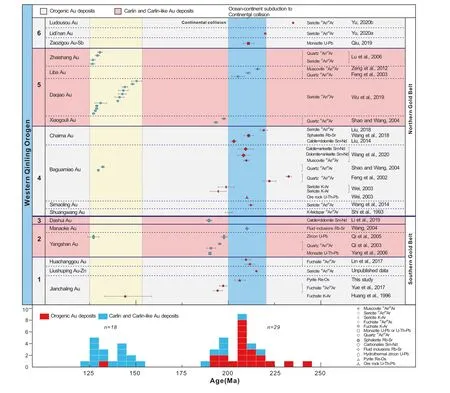
Fig.6 Summary diagram illustrating the ages of Au deposits in the West Qinling Orogen.Data sources are listed in Table 3
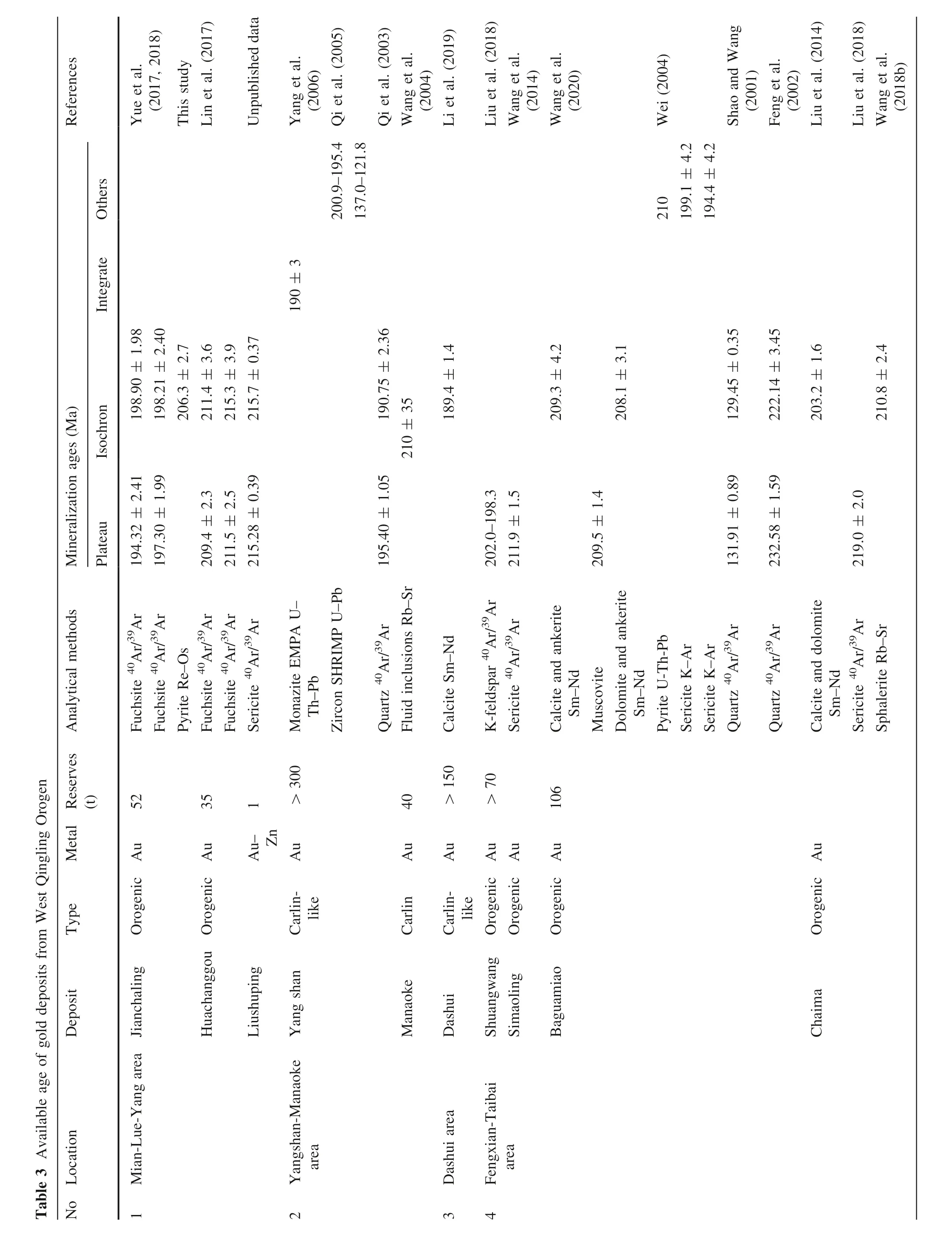
References Others Yue et al.(2017, 2018)This study Lin et al. (2017)Unpublished data Yang et al.(2006)200.9–195.4 Qi et al. (2005)Qi et al. (2003)Wang et al.(2004)Li et al. (2019)137.0–121.8 Liu et al. (2018)Wang et al.(2014)Wang et al.(2020)Wei (2004)Shao and Wang(2001)Feng et al.(2002)Liu et al. (2014)210 199.1 ± 4.2 194.4 ± 4.2 Liu et al. (2018)Wang et al.(2018b)Integrate 190 ± 3 Mineralization ages (Ma)Isochron Plateau 198.90 ± 1.98 198.21 ± 2.40 206.3 ± 2.7 211.4 ± 3.6 215.3 ± 3.9 215.7 ± 0.37 194.32 ± 2.41 197.30 ± 1.99 209.4 ± 2.3 211.5 ± 2.5 215.28 ± 0.39 190.75 ± 2.36 210 ± 35 195.40 ± 1.05 189.4 ± 1.4 202.0–198.3 211.9 ± 1.5 209.3 ± 4.2 208.1 ± 3.1 209.5 ± 1.4 129.45 ± 0.35 131.91 ± 0.89 222.14 ± 3.45 232.58 ± 1.59 203.2 ± 1.6 210.8 ± 2.4 219.0 ± 2.0 Analytical methods Fuchsite 40Ar/39Ar Fuchsite 40Ar/39Ar Pyrite Re–Os Fuchsite 40Ar/39Ar Fuchsite 40Ar/39Ar Sericite 40Ar/39Ar Monazite EMPA U–Th–Pb Zircon SHRIMP U–Pb Quartz 40Ar/39Ar Fluid inclusions Rb–Sr Calcite Sm–Nd K-feldspar 40Ar/39Ar Sericite 40Ar/39Ar Calcite and ankerite Sm–Nd Muscovite Dolomite and ankerite Sm–Nd Pyrite U-Th-Pb Sericite K–Ar Sericite K–Ar Quartz 40Ar/39Ar Quartz 40Ar/39Ar Calcite and dolomite Sm–Nd Sericite 40Ar/39Ar Sphalerite Rb–Sr Table 3 Available age of gold deposits from West Qingling Orogen Metal Reserves(t)Type Deposit No Location 52 Orogenic Au Mian-Lue-Yang area Jianchaling 1 35 Huachanggou Orogenic Au 1>300 Au–Zn Au Carlinlike Liushuping Yang shan Yangshan-Manaoke area 2 40 Au Carlin Manaoke>150>70 Au Carlinlike Orogenic Au Dashui Shuangwang Orogenic Au Simaoling Dashui area Fengxian-Taibai area 3 4 106 Orogenic Au Baguamiao Orogenic Au Chaima
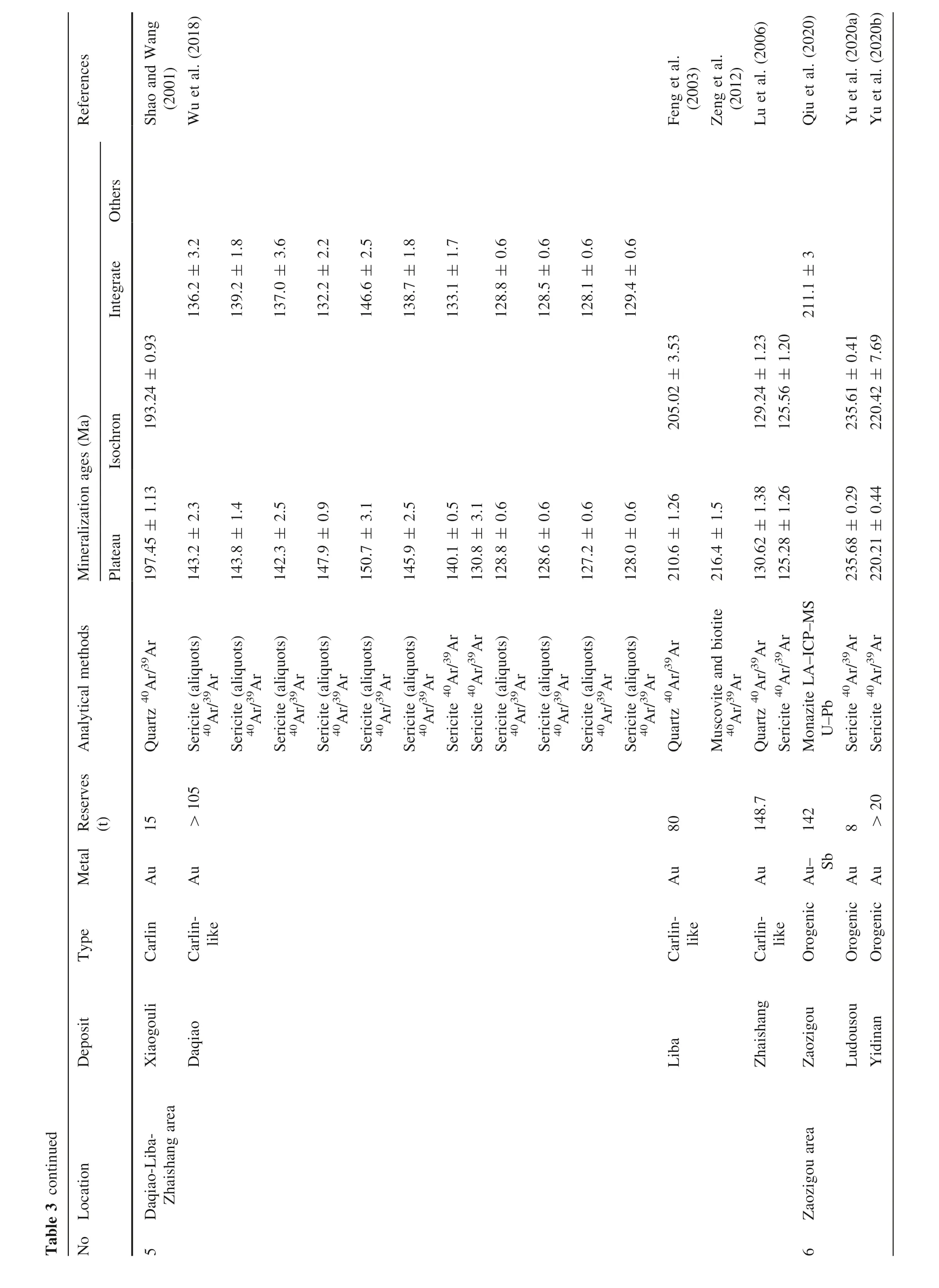
References Shao and Wang(2001)Wu et al. (2018)Feng et al.(2003)Zeng et al.(2012)Lu et al. (2006)Qiu et al. (2020)Yu et al. (2020a)Yu et al. (2020b)Others Integrate 136.2 ± 3.2 139.2 ± 1.8 137.0 ± 3.6 132.2 ± 2.2 146.6 ± 2.5 138.7 ± 1.8 133.1 ± 1.7 128.8 ± 0.6 128.5 ± 0.6 128.1 ± 0.6 129.4 ± 0.6 211.1 ± 3 Mineralization ages (Ma)Isochron Plateau 193.24 ± 0.93 197.45 ± 1.13 143.2 ± 2.3 143.8 ± 1.4 142.3 ± 2.5 147.9 ± 0.9 150.7 ± 3.1 145.9 ± 2.5 140.1 ± 0.5 130.8 ± 3.1 128.8 ± 0.6 128.6 ± 0.6 127.2 ± 0.6 128.0 ± 0.6 205.02 ± 3.53 210.6 ± 1.26 216.4 ± 1.5 129.24 ± 1.23 125.56 ± 1.20 130.62 ± 1.38 125.28 ± 1.26 235.61 ± 0.41 220.42 ± 7.69 235.68 ± 0.29 220.21 ± 0.44 Analytical methods Quartz 40Ar/39Ar Sericite (aliquots)40Ar/39Ar Sericite (aliquots)40Ar/39Ar Sericite (aliquots)40Ar/39Ar Sericite (aliquots)40Ar/39Ar Sericite (aliquots)40Ar/39Ar Sericite (aliquots)40Ar/39Ar Sericite 40Ar/39Ar Sericite 40Ar/39Ar Sericite (aliquots)40Ar/39Ar Sericite (aliquots)40Ar/39Ar Sericite (aliquots)40Ar/39Ar Sericite (aliquots)40Ar/39Ar Quartz 40Ar/39Ar Muscovite and biotite 40Ar/39Ar Quartz 40Ar/39Ar Sericite 40Ar/39Ar Monazite LA–ICP–MS U–Pb Sericite 40Ar/39Ar Sericite 40Ar/39Ar Metal Reserves(t)Type 15 Au Carlin>105 Au Carlinlike 80 Au Carlinlike 148.7 Au Carlinlike 142 8>20 Orogenic Au–Sb Orogenic Au Orogenic Au Deposit Xiaogouli Daqiao Liba Zhaishang Zaozigou Ludousou Yidinan Table 3 continued No Location Daqiao-Liba-Zhaishang area 5 Zaozigou area 6
In other words, from the oceanic subduction at the end of the Triassic to the continental collision at the beginning of the Jurassic, the Bikou terrane subducted below the Qinling microplate, causing large-scale metamorphic dehydration and decarburization and producing metamorphic fluids.The ore-forming metamorphic fluids migrated upward and deposited in the ductile–brittle faults of the ductile shear zone, forming gold mineralization in Jianchaling, Lijiagou, and Huachanggou (Fig.7).The metamorphic fluids have also reworked gold-rich volcanic rocks and further enriched them forming the Donggouba Ag-Au-Pb–Zn deposit.

Fig.7 Tectonic model for the Mian-Lue-Yang Au deposits
In summary, the southern ore belt of the WQO was formed in the late stage of the closure of the Mian-Lue ocean and may experience the transition from oceanic subduction to continental collision.
6 Conclusions
The Re–Os ages of the pyrite samples indicate that the gold mineralization at Jianchaling is ca.206 Ma, namely the deposit was formed during the Late Triassic and Early Jurassic.The Jianchaling gold deposit is an orogenic-type deposit formed during the transition from oceanic subduction to continental collision.
AcknowledgementsThis study is financially supported by the National Natural Science Foundation (No.41403032), the National Crisis Mine Prospecting Foundation (No.20089934) and the discipline construction project of Guangzhou City University of Technology (No.60-CQ190025).The fieldwork was supported by the Exploration Team 711 of Northwest Mining and Geology Group Co.,Ltd.We are grateful to Yang Yu Bo for help during Re–Os pyrite isotopic analyses.Comments and suggestions from editors and reviewers had greatly improved the quality of the paper.
Declarations
Conflict of interestWe declare no conflicts of interest in this study.
- Acta Geochimica的其它文章
- Acta Geochimica
- Genetic links of porphyry Mo-epithermal Pb–Zn–Ag mineralization system: a case study of the Shipingchuan polymetallic deposit, South China
- Geochronology and geochemistry of the W-Mo-ore-related granitic rocks from eastern Ningzhen, lower Yangtze river belt,eastern China
- Lower activity time constraint on the ore-controlling Erdaogou fault in the Qingchengzi orefield of the Liaodong Peninsula, NE China
- Ore-forming age and tectonic setting of the Linjiasandaogou gold deposit in the Liaodong Peninsula, northeast China: constraints from geochronology and geochemistry
- Trace element and sulfur isotope compositions of pyrite from the Tianqiao Zn–Pb–Ag deposit in Guizhou province, SW China: implication for the origin of ore-forming fluids

